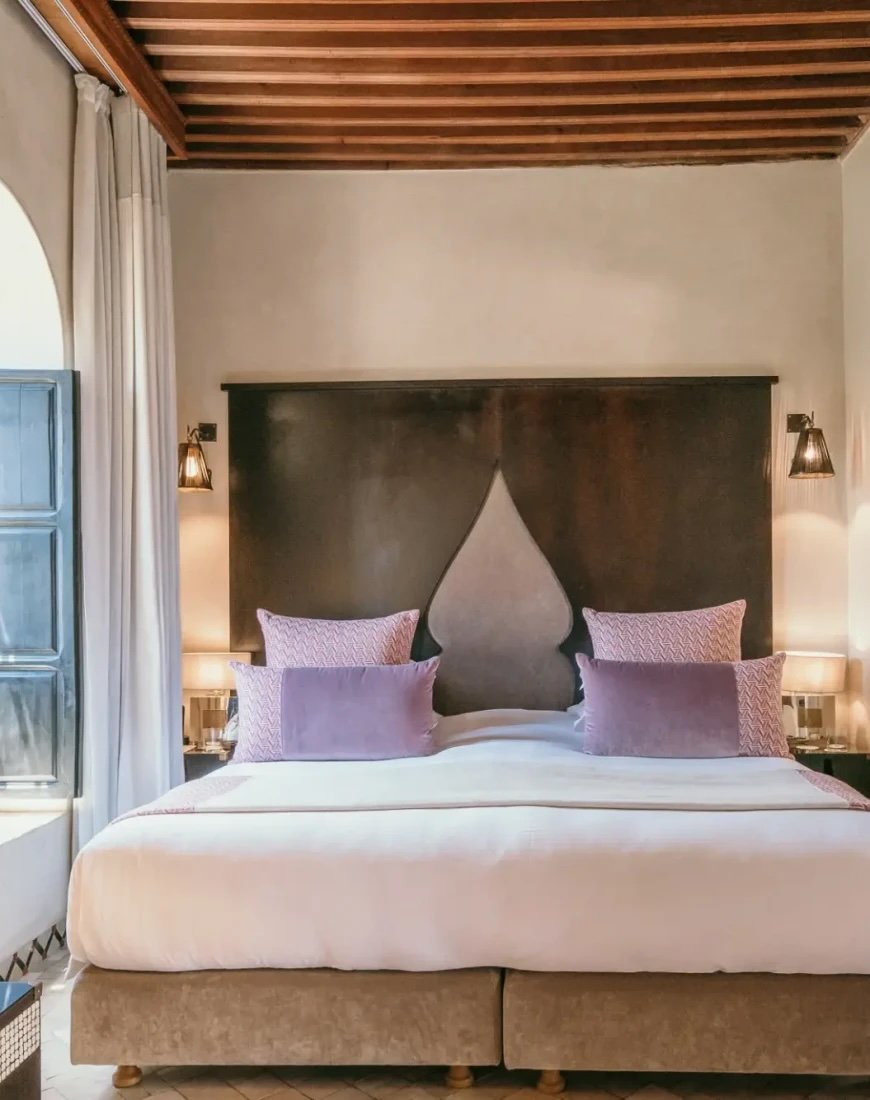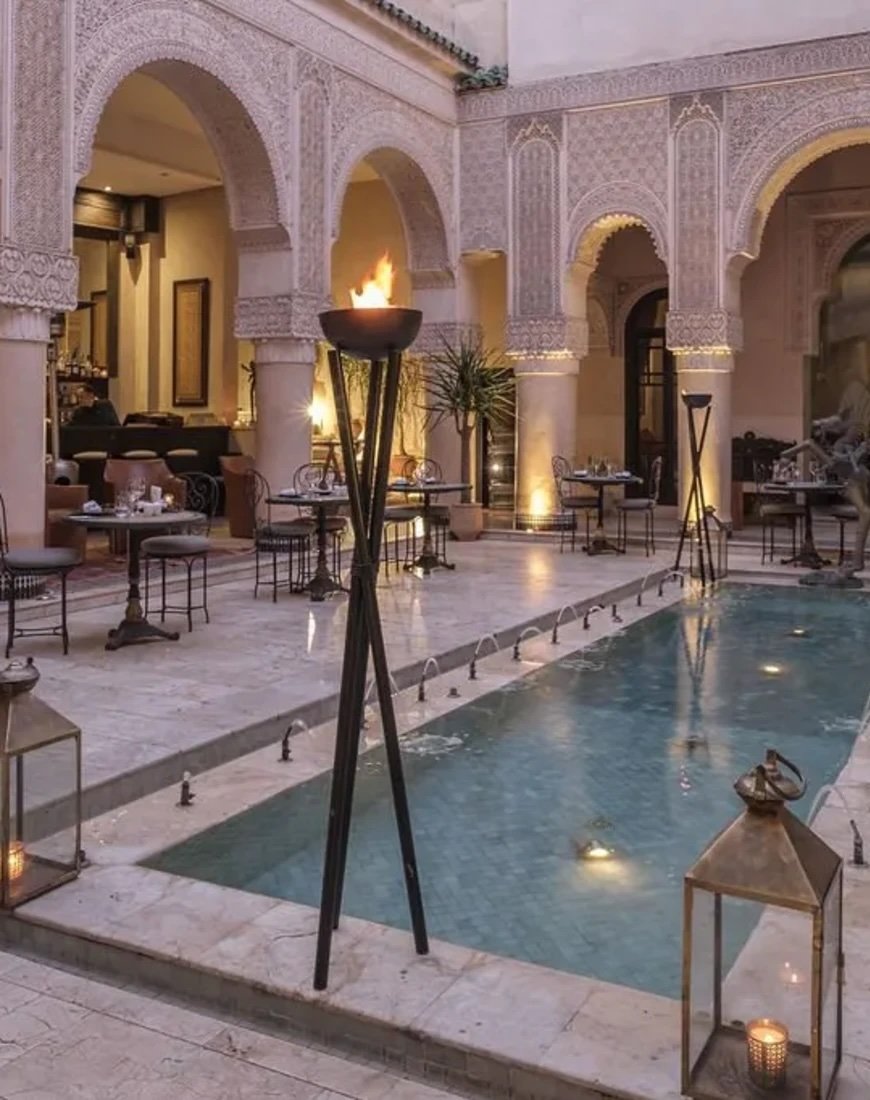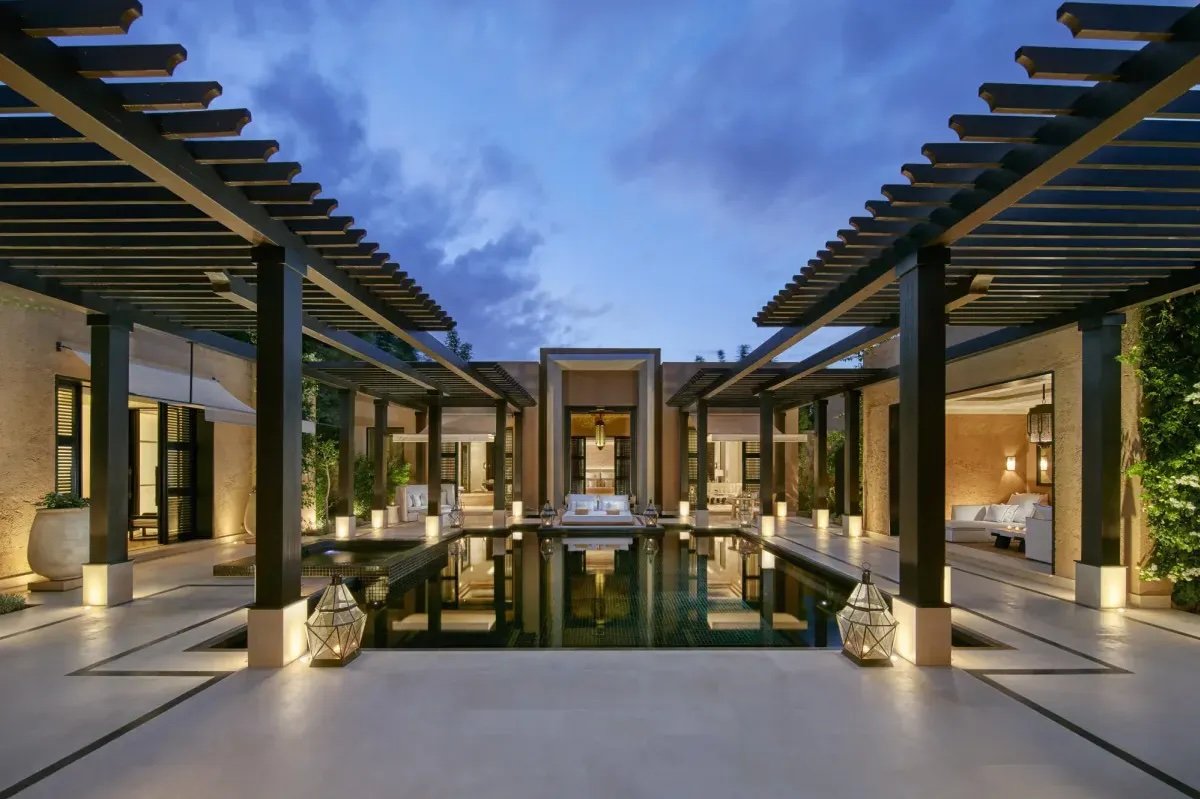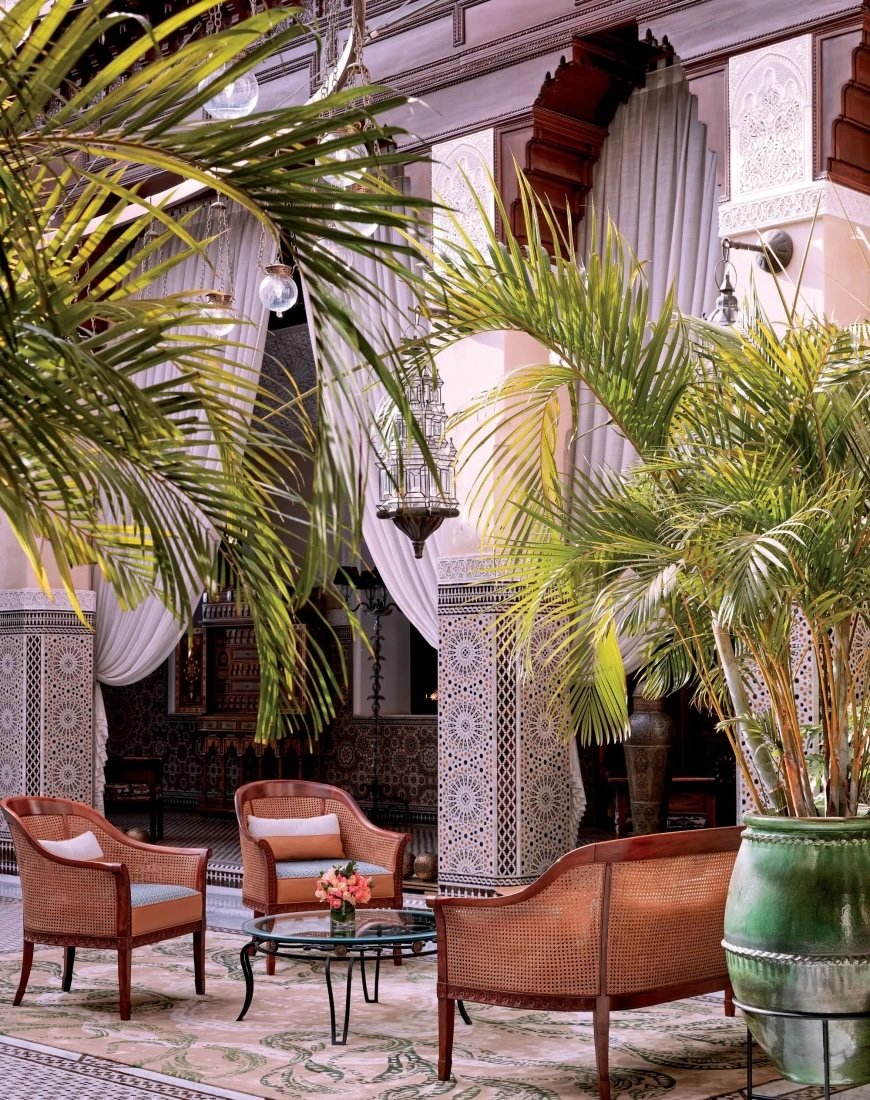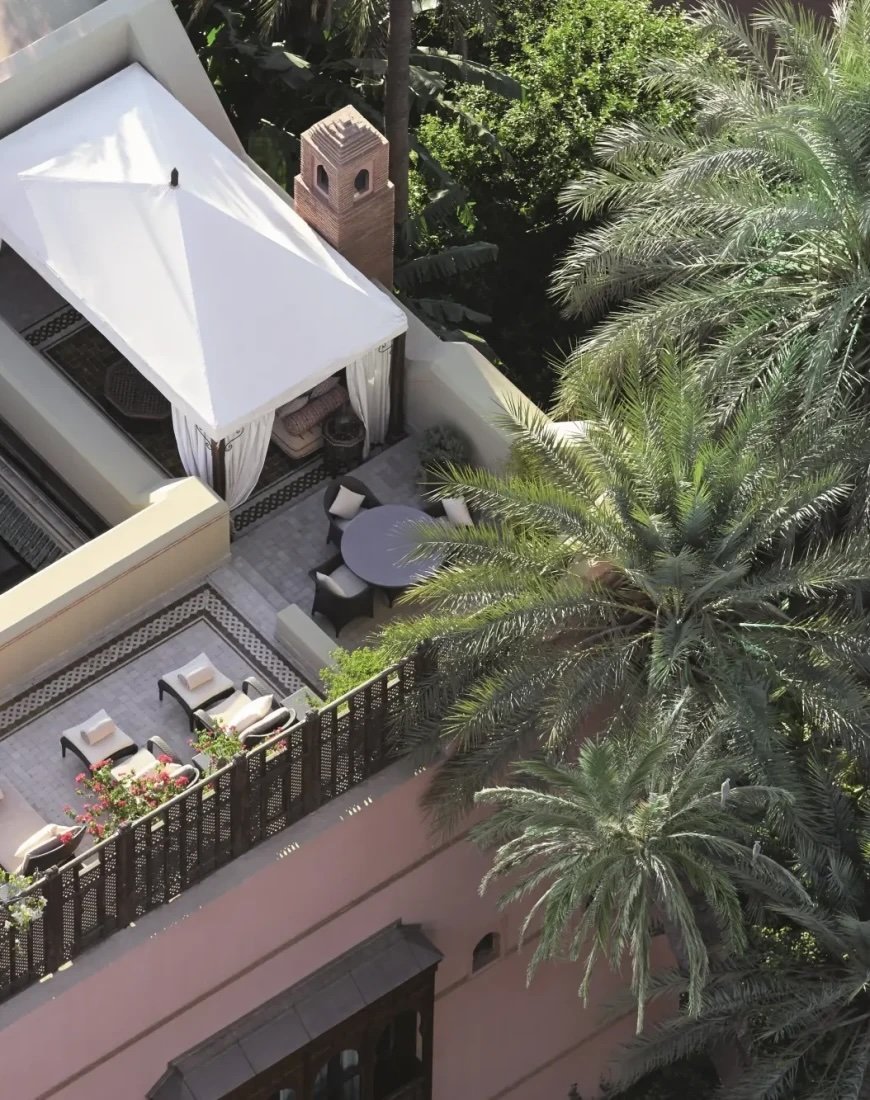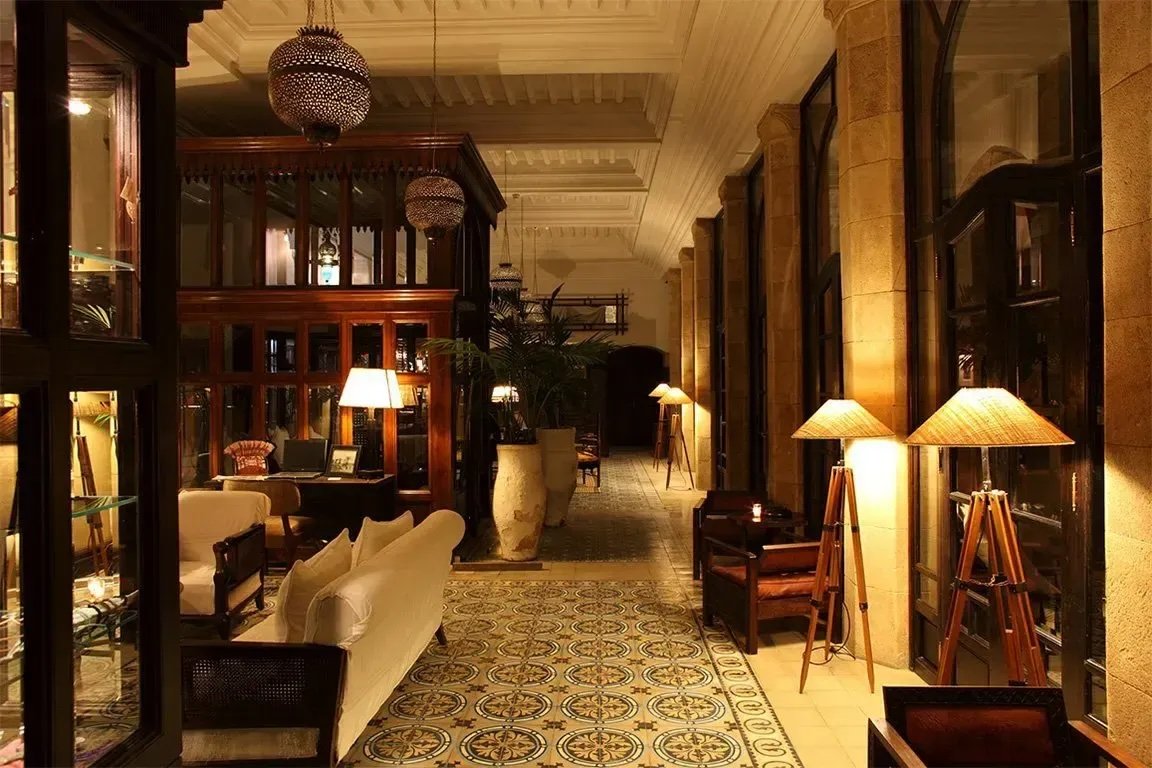An Insider's Guide to Where to Eat, Stay & Play in Morocco
Image courtesy of Amanjena
If you’re looking to be enchanted, consider Morocco. The country offers a bit of everything: dynamic multiculturalism, stunning architecture, vibrant cities, beaches, nature escapes…Whatever your travel style, Morocco more than delivers.
Meander the maze-like souks, marketplaces and medinas (historical districts) of the country’s urban centers, from Casablanca to Fez, Marrakech to Essaouira. Savor fragrant tagines, herbal teas, fresh seafood and spices galore. Marvel at the intricate tilework and calligraphy that adorns much of Morocco’s buildings. Relax in a traditional hammam. Hike the Atlas Mountains. You won’t be at a loss for things to enjoy.
Morocco offers so much, and you'll want to build out your itinerary based on the time you have available, as well as your goals for what you want to see. Below, I’ve put together a sample itinerary of a few favorite places to visit, plus where to stay, what to do and where to eat in each location. (The country's allure extends well beyond these spots.) If you're flying from the States and want to stick to a direct flight, you’ll fly into Casablanca, Morocco’s commercial hub. From New York City, it's only a seven-hour flight. You can also opt for a layover somewhere like Amsterdam or Paris.
The below is just a sample of all that’s available, of course, rooted in Fes, Marrakech and Essaouira, each of which has a unique vibe. Depending on your travel style and preferences, you may want to spend more time here, a little less time there. Everything can be customized. (For instance, if you want to spend more time in the desert, we can swap out one of the destinations.) Not to worry: connect with me, and I’ll tailor a dream itinerary specific to you. Regardless, Morocco is calling, and now is the perfect time to travel.
The quick and dirty:
Currency: د.م., Moroccan Dirham (MAD); even better, it's currently 10 to one for the US dollar, so conversions are super easy
Languages: Arabic and Amazigh, and many speak French as well as English
Airports: Casablanca Mohammed V International Airport (CMN), Fès–Saïss Airport (FEZ), Marrakesh Menara Airport (RAK)
Transportation: You can consider enlisting a guide and private transfers when visiting, which will help ensure you don’t get lost and provide helpful, fascinating context for all the sites you visit. But you can certainly travel here without one. Improved infrastructure is coming for city-to-city transportation. The 2030 World Cup will be here, and with it, the country is building a new high-speed rail.
Best time to visit: You can visit any time of year, and what your interests are (hiking, beach, desert exploring, cultural sites, etc.) will help determine the ideal time to go. For instance, the summer is hot, but it's also a great time to visit Morocco's beaches, where the sea helps temper the heat. January offers really nice & mild weather (plus fewer crowds), and the fall also tends to be quite lovely (and less crowded). Connect with me and we’ll work together to decide when the best time to visit is for you, based on your travel style.
Ideal length of stay: Luckily, Morocco is conducive to trips of varying lengths. If you're only going to Marrakech, for example, you could totally plan a 3- or 4-day trip. If you're visiting multiple spots, 9-10 might be the sweet spot. It's all about maximizing the time you have with your bucket-list items. And no doubt, you'll be scheming a return visit before you leave the country.
Signature dishes: tagine (stew cooked in a clay vessel of the same name), chermoula (a mix of olive oil, herbs and spices), m’smen (buttery flatbread), sfinj (doughnuts often served with honey or sugar), kalinté (street-food bread made with chickpea flour)
Key phrases: as-salaam alaykum (hello), shokran (thank you), afak (please), yalla (let's go)
Dress code: flowy dresses and linen everything — and bring a shawl to cover your shoulders when visiting holy sites
Casablanca
Casablanca, Morocco’s commercial capital, is where you’ll fly into. If it’s your first time in the country, you likely won’t be spending much time here. But the city is bustling and fascinating, a reflection of the various cultures that have inhabited and influenced it over the years, including the Portuguese, Spanish and French. (The Spanish are responsible for its modern name, Casablanca, although the Portuguese originally called it Casa Branca before the Spanish settled in.) Here you’ll find a combination of both traditional and Art-Deco architecture, the remnant of the French occupation and colonial rule from the early to mid-20th century.
Image courtesy of Four Seasons Hotel Casablanca
Where to stay in Casablanca
Four Seasons Hotel Casablanca: A solid landing pad after a long flight, with a beachfront location and five-star amenities. When you book Four Seasons with me, you’ll enjoy exclusive Four Seasons Preferred Partner amenities. I’ll be pleased to give you more details.
Mazagan Beach & Spa Resort: A sprawling, luxury haven about an hour outside of Casablanca. It's ideal for families and couples alike, with numerous activities from surfing and paddleboarding to laser tag and archery. Fora's VIP Reserve partner perks include welcome amenities, breakfast daily, an upgrade & extended check-in/out whenever possible.
Royal Mansour Casablanca: The luxury hotel brand has brought its signature five-star Moroccan charm to a new location in Casablanca.
What to do in Casablanca
Your time in Casablanca is limited, but the Hassan II Mosque, Morocco’s largest, is a must. Wander around the downtown area to see the Art-Deco architecture. The city’s Marché Central (Central Market) is always abuzz and perfect for perusing produce, herbs, spices, crafts and more. The souks of the Habous neighborhood are also perfect for picking up authentic souvenirs. If time allows, head to the Museum of Moroccan Judaism, the Arab world’s only museum dedicated to Judaism, and Derb Ghallef, Morocco’s largest second-hand flea market.
Where to eat in Casablanca
For traditional Moroccan food served in an open-air setting, head to La Sqala, located in Casablanca’s historic medina. Also in the medina is the beautiful Dar Dada, where Moroccan cuisine is served in a tasteful riad setting. Rick's Café focuses on American and European dishes, with an ambiance inspired by the classic film Casablanca (live piano music, lavish balconies, ornate brass light fixtures). For something trendy and casual (but still delicious and well made), NKOA, just off of the Arab League Park is a great choice. For something truly special, I love the no-frills restaurant run by l’Association Solidarité Feminine, a non-profit that trains and employs single mothers in roles like cooking, baking and catering.
Fes
Fes (or Fez), founded in the late eighth century, is Morocco’s spiritual and cultural capital. (It used to be the country’s official capital, but today Rabat holds that title.) Here is where to go to really immerse yourself into Morocco's vibrant, dynamic culture. Fes is among the country’s more traditional cities, where its rich tradition is front and center. Plus, its medina is among the world’s largest car-free urban zones, and is perfect for mindful wandering.
Images courtesy of Riad Fes
Where to stay in Fes
Riad Fes: A special spot comprising six gorgeously appointed houses, where each space is completely unique, and where part of the charm lies in getting lost in its showstopping design. Book with me to receive $25 hotel credit, a welcome amenity, an upgrade and late check-out.
Hotel Sahrai: A contemporary option with a rooftop bar perfect for watching the sunset, glass of Moroccan wine in hand. (Although Hotel Sahrai is Riad Fes' sister property, the two properties have completely different vibes.) Fora’s SLH withIN partner perks include $50 hotel credit, breakfast daily, an upgrade and extended check-in/out.
Palais Amani: A 21-room riad ideal for a more local, authentic experience.
What to do in Fes
Fes is particularly well known for its leather tanneries. Visit the 11th-century Chouara Tannery to observe the traditional craft. In fact, you can get a custom piece made here, and they'll deliver it to your hotel a few hours later. The University of al-Qarawiyyin, founded in 859 AD, is the world's oldest learning institution still in operation. Take in the college’s architecture decorated with elaborate calligraphy, and browse its historic library, where you’ll find centuries-old copies of the Qu’ran. For a stellar view, explore the Merenid Tombs, perched on a hilltop to the city’s north.
Where to eat in Fes
Fes’ street-food game is strong. Meander around the souks and markets and sample traditional fare prepared by local cooks and artisans. For traditional cooking with a gourmet twist, Riad Fes’ exceptional restaurant Gayza serves Moroccan dishes in an elegant, fun, colorful space. The plant-filled Ruined Garden is a delightful oasis for a nourishing lunch after a morning spent exploring, while the chic, modern hotspot Nur is perfect for an elaborate tasting menu in a sleek setting. The rooftop l’Amandier, at Palais Amani, marries French, Jewish, Arab, Moorish and Amazigh culinary traditions, and restaurant Eden, in the Palais Amani hotel, serves refined international cuisine with Moroccan and French influences.
Marrakech
Marrakech is home to a maze of charming courtyards, bustling souks, elegant palaces, intricate tile work and, of course, some of Morocco’s most famous hotels. The energy of this city is palpable and unending — in the best way (even more reason to visit a hammam here to unwind and reset).
Image courtesy of Mandarin Oriental Marrakech
Where to stay in Marrakech
The Oberoi Marrakech: An opulent stunner with hand-crafted architecture, sweeping views of the Atlas Mountains and an impeccable attention to detail when it comes to hospitality. Book with me to receive a complimentary 50-minute massage for two, breakfast daily, an upgrade and extended check-in/out.
Amanjena: Design-forward and stunning, softly boasting the tranquility you’d expect from Aman’s signature minimalist approach. When you book with me, you’ll get $100 food / beverage credit, breakfast daily, an upgrade and extended check-in/out.
Royal Mansour Marrakech: A centrally located medina-within-a-medina that gives you a riad-esque experience with the amenities of a hotel. Book with me to snag Fora’s exclusive partner perks, including $100 food / beverage credit, complimentary roundtrip private airport transfers, breakfast daily, an upgrade and extended check-in/out whenever possible.
La Mamounia: One of Morocco’s most iconic properties, complete with indoor and outdoor pools, a small cinema and recently renovated opulence. Fora’s VIP partner perks include $100 food / beverage credit, breakfast daily, an upgrade and extended check-in/out.
Mandarin Oriental Marrakech: A 63-room retreat that checks all the boxes — beautiful rooms, a great common area and stunning views. When you book Mandarin Oriental with me, you’ll enjoy exclusive Fan Club preferred partner amenities. I’ll be pleased to give you more details.
Images courtesy of Royal Mansour Marrakech
What to do in Marrakech
You’ll want to explore the souks, of course, but to avoid getting lost, enlist the help of an expert (which I can help you with, of course). The famed Jardin Majorelle (Majorelle Gardens), with its royal blue buildings and colorful botanical gardens is well worth a visit. In the 80s, the gardens were purchased by the fashion designers Yves Saint-Laurent and Pierre Bergé, and the gardens’ neighbor, the Yves Saint Laurent Museum, is also very much worth a visit. Pro tip: visit in the afternoon, when there are fewer crowds. Also within the Majorelle Gardens is the Pierre Bergé Museum of Berber Arts, which pays homage to the traditional Amazigh craftwork. The Anima botanical gardens are also lovely, and come with less crowds in general. Explore the bustling Djema El Fna square, where you’ll find local artisans selling their wares, fruit stands, traditional medicine outlets, fortune tellers and so much more.
Where to eat in Marrakech
The leafy Le Jardin serves traditional Moroccan fare, alongside some international options, in a chicly renovated 16th-century building. Nomad Marrakech is cozy and casual, and champions local ingredients. Another cozy and casual — and bright and colorful — option is Bacha Café, perfect for a coffee and a pastry. Head to the dimly lit Dar Yacout for fine dining in an upscale atmosphere, and to La Terrasse des Épices for a fashionable rooftop moment (plus delectable locally sourced dishes). Enjoy another rooftop moment, complete with sushi and cocktails, at Kabana. At the Oberoi’s signature restaurant Rivayat, savor Indian food prepared by a Michelin-Starred chef. At Nama, located in Amanjena, five-star Japanese food is prepared with sustainably sourced, local ingredients.
Atlas Mountains
The energy of Morocco's cities is a must, but so is the tranquility offered by the Atlas Mountains, home to a network of Amazigh villages. Amazigh is the local name for the Indigenous group of people whom we typically refer to as Berber. The word is not favored, however, because it's rooted in an ancient Greek word that means barbarian. If you’re into active travel, the Atlas Mountains will prove especially attractive. Here you can hike Mount Toubkal, North Africa’s highest point, and explore the numerous trails within Toubkal National Park.
This region is the area most impacted by last year's earthquake. Many of the hotels have reopened now, but some are still rebuilding. Whether you're staying for an extended amount of time (highly recommend) or doing a day trip (totally doable; a hike & Amazigh tea is the best day), visiting is one of the most important ways we can help them to rebuild.
Essaouira
This beachside city has been inhabited since ancient times, but the Portuguese are credited with establishing the official town when they built a fort there in the early 1500s. Essaouira is a bucket-list destination for windsurfers and kitesurfers. But if watersports aren’t your thing, the beaches are also lovely for lounging. Its laid-back, bohemian vibe makes it the perfect place to end your vacation. Be sure to pick up some local argan oil from a local women's co-op. This is a great way to help close the gender gap in Morocco. Handmade crafts made out of rare thuya wood also make special souvenirs.
Image courtesy of Heure Bleue Palais
Where to stay in Essaouira
Heure Bleue Palais: A boutique gem (and former home) with 33 rooms, traditional Moroccan design, a beautiful riad-style garden and approachable rates. Book with me to receive Relais & Châteaux partner perks, including daily breakfast and a VIP welcome.
What to do in Essaouira
In between beach time, explore Essaouira’s eclectic array of art galleries, including Le Real Mogador, a former mansion displaying the work of Moroccan artists, and Galerie la Kabash, a three-story hub with a collection of both local and international pieces, plus furniture, sculpture, pottery, carpets and more. In Essaouira’s Jewish quarter, you’ll find Bayt Dakira, a museum that highlights the coexistence of Jews and Muslims in the area.
Where to eat in Essaouira
Dar Baba is fun and lively, with a Mediterranean fusion menu and colorful environs, while La Clé de Voûte is charming and casual. Save room for a wine tasting at Le Domaine du Val d'Argan winery, which uses stainless steel fermentation to produce over 300,000 bottles of organic wine. And the restaurants at Heure Bleue Palais are some of the best in town: the elegant Salon Oriental is the hotel’s fine-dining restaurant, the rooftop Terrace Grill is perfect for a poolside lunch and the handsome English Lounge is a must for a cocktail nightcap by the fire. La Table Madada serves fresh seafood and a fusion of Moroccan and Mediterraneans fare, while Caravane Café’s menu focuses on international cuisine (with seafood and vegetarian options), and is served in a fun, eclectically decorated setting.
This may be information overload, but that's where I come in. Above is just a taste of all that Morocco offers. Connect with me for a tailored trip. I'll work to understand your vibe and what you're after, and design your dream Morocco getaway, complete with VIP perks and priority status at the country's best hotels.



